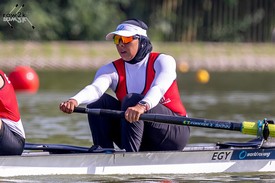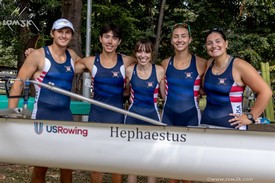According to Carlo Zezza

The truth: As standardized by USRowing, and by the Head of the Charles Regatta for 60+ age divisions, existing age handicaps favor older rowers more than their decline in performance. The Head of the Charles handicap is closer to reality. Both are based on 1km results, and both have been used for years without updating.
Based on six years of results at the Head of the Charles, it's possible to compare with reality - the method is described as a note at the end:
| 60-69 "Veteran" men 1x - Head of the Charles | ||
|---|---|---|
| ? | In seconds | In percent |
| Real decline | 5.45 sec's/yr | 0.39%/yr |
| Head of the Charles h'cap | 8.0 sec's/yr | 0.58%/yr |
| USRowing at 4.8km (for 65 yr old) | 9.12 sec's/yr | 0.65%/yr |
Decline for the 50-59 group - The 50-59 "Grand Masters" don't get an age handicap at the Head of the Charles. They probably should, because their performance falls off more than the Veterans - in percentage as well as absolute. USRowing's sliding scale handicap slides the wrong way from 50 to 69. Here's the observed result, compared to USRowing.
| 50-59 "Grand Master" men 1x - Head of the Charles | ||
|---|---|---|
| ? | In seconds | In percent |
| Real decline | 5.95 sec's/yr (5.45 for Veterans) | 0.45%/yr |
| USRowing at 4.8km (for 55 yr old) | 6.72 sec's/yr (9.12 for 65 yr old) | 0.50%/yr |
Best competitors versus the average - The preceding includes everybody in each age group. The fastest Grand Masters slow down more than the average as they get older. i.e. the difference between best and average becomes smaller with increasing age.
This is true in other sports, like Crash-B's, Ironman Triathlon, and World Swimming Championships, where the best competitors also slow down more than the average.
The fastest Veterans (60-69) are an exception. The fastest Veterans slow down less than the average as they get older. Why? It's probably because older rowers have already lost much of their power, and efficient technique becomes proportionally more important.
Here's a comparison of "best" versus all the rest, including Crash B's '99-'05:
| Men 1x | Rowing (4.8km) | Crash-B Erg (2.0km) | ||||||
| 50 - 59 | 60-69 | 50-59 | 60 - 69 | |||||
| Best | All | Best | All | Best | All | Best | All | |
| Decline in sec's/yr | 9.48 | 5.95 | 4.78 | 5.45 | 2.58 | 1.80 | 7.19 | 3.55 |
On the erg, power is king, as shown by the dramatic fall-off among the best 60-69 year-olds.
Conclusions?
Some "frequently asked questions" are noted below, along with some opinions.
Are handicaps a good idea? Or, should masters' racing be divided into five-year brackets with no handicaps - the FISA model?
This writer believes that handicaps should be widely used, because they stimulate better competition.
Competition is best when nobody knows who will win. More competitors mean more uncertainty, and better competition. Too often, in five-year age brackets, the field is small and the outcome is settled before the start - that's not good racing, even for the favorite.
Age handicaps can expand age divisions and bring more rowers into the same race, where it's more likely that the outcome will be in doubt.
Lack of a handicap diminishes competition by discouraging entries. In the un-handicapped Masters and Grand Masters events at the Head of the Charles, we see excellent single scullers moving over to doubles as they near the top of their age bracket - reducing the number of competitors in singles. Without disparaging the doubles, it would be better competition if all the best scullers were concentrated in the same events.
A great race can be staged in a single event without any age divisions, using an all-age handicap. The second "GMS Challenge", completed last month at the GMS Rowing Center in New Milford, CT, shows how. The formula:
-- one prize for all ages in a single event
-- a reality-based handicap that is fair to all ages
The GMS' handicap system (visible at www.GMSrowingcenter.us - "regatta" page) was validated by the results of the race on September 25th - The top five male open finishers included 2 40+s, a 50+ (the winner), a 60+ and a 70+. The dispersion of ages continued throughout the results.
Should existing handicaps be changed to reflect reality? They should, if "fairness" is the only goal. But encouraging older rowers to stay in competition has merit beyond fairness.
One reason to favor age is unique to the Head of the Charles. Finishing within 5% of the winning time guarantees entry the following year. At the top of the age bracket, other older rowers besides the top finishers benefit from a favorable bias, and the following year's regatta can get a better dispersion of ages.
A brilliant row can still overcome the Head of the Charles bias. For instance, Duncan Howat's 2004 win at the Head of the Charles, in his first year as a Veteran.
An age handicap for the 50-59 group would be especially appropriate, because of the falloff in performance in these years.
At regional regattas where participation by older rowers is spotty, it makes sense to encourage an older turnout, although USRowing's system is truly over-generous.
* Note on the method
Real performance decline was determined by recording male single sculler raw times at the Head of the Charles from 1999 to 2005, excluding 2004 when the course was shortened. Grand Masters' ages could not be recovered for 1999 and Grand Masters' 1999 results were not included.
Course penalties were ignored. Year-on-year weather differences were eliminated by adjusting each year's raw times to a common median. The median times were 1334 seconds for Grand Masters, and a small minute slower, 1390 seconds, for Veterans. These medians were the base, in determining the percent/year performance decline.
The "best" competitors were those with the best time, each calendar year, in each year of age, i.e. the 1st 50 yr old, the 1st 51 yr old, etc. "Best" median times were 1260 seconds for Grand Masters, and just 38 seconds slower, 1298 seconds, for Veterans. "Best" Veterans slow down less than the average, as commented above.
A statistical plug-in for Excel was used to identify/eliminate a few exaggerated slow times. The same program calculated the slope of the age/performance decline, by linear regression analysis.
Over 500 data points were collected. The points don't line up, instead they look like a cloud. For anyone statistically inclined, the "R" value for correlation (where "1" is a perfect line and "0" is no correlation at all) is rather low: 0.21 for the Grand Masters, and 0.15 for the Veterans. The correlation was better for the "best" - 0.51 for "best" Grand Masters, and 0.26 for "best" Veterans.
The inquiry was not extended to Senior Veterans (70+) and women scullers. There are not enough entries to be meaningful. It seems likely that more data points in their events would provide similar conclusions.
Trying to track individual performance decline over the years is an exercise in futility. It is almost impossible to select an individual without running into extraneous influences, besides advancing age.
Comments, questions, or objections are welcome via email to [email protected].
If you enjoy and rely on row2k, we need your help to be able to keep doing all this. Though row2k sometimes looks like a big, outside-funded operation, it mainly runs on enthusiasm and grit. Help us keep it coming, thank you! Learn more.
- Bont Rowing
- Calm Waters Rowing
- Concept 2
- Craftsbury Sculling
- The Crew Classic
- CrewLAB
- Croker
- Durham Boat Co.
- Empacher
- Faster Masters
- Filippi
- Fluidesign
- h2row.net
- HUDSON
- Live2Row Studios
- Nielsen-Kellerman
- Oak Ridge RA
- Peinert Boat Works
- Pocock Racing Shells
- Race1 USA
- RowKraft
- Rubini Jewelers
- Vespoli USA
- WinTech Racing
- Bont Rowing
- Calm Waters Rowing
- Concept 2
- Craftsbury Sculling
- The Crew Classic
- CrewLAB
- Croker
- Durham Boat Co.
- Empacher
- Faster Masters
- Filippi
- Fluidesign
- h2row.net
- HUDSON
- Live2Row Studios
- Nielsen-Kellerman
- Oak Ridge RA
- Peinert Boat Works
- Pocock Racing Shells
- Race1 USA
- RowKraft
- Rubini Jewelers
- Vespoli USA
- WinTech Racing

















